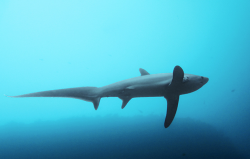select your film:


The common thresher shark, also known as fox shark or swiveltail, is the largest member of the thresher family. Adults are on average about 4.5 meters long, and some individuals grow to be 6 meters. Their most distinctive feature is their very long tail, which can be up to 3 meters long. This enormous tail is used as a whip to stun prey, such as herrings and anchovies. To do this, they find a school of fish and swim around it to compress it and then hit it quickly, often stunning several fish simultaneously.
Beside its tail, the common threshers have some useful adaptations that make them fierce predators. They’re fast swimmers, powerful enough to leap out of the water. They can generate a maintain body heat better than most other sharks. And they have about 50 rows of teeth, with sharp triangular teeth ideal to catch small prey.
The common thresher is very similar to the pelagic thresher (Alopias pelagicus), but they be told apart by the common thresher’s white belly, which extends in a band over the bases of its pectoral fins.
Common threshers are a vulnerable species due to overfishing and to their slow reproduction cycles. They’re listed in CITES appendix II, which means they can’t be exported without a permit. The species is protected in some regions such as California, but internationally they’re not managed and there are no quotas.
Do you have images or videos of Common Thresher Sharks?
Submit them to [email protected].
